The Perfect Fusion: Crafting Timeless Traditional Modern Kitchen Designs
The kitchen has long been revered as the true heart of any home, a vibrant sanctuary where cherished family memories are forged, and culinary artistry comes to life. When embarking on the design journey for this pivotal space, homeowners frequently find themselves at a crossroads, needing to choose between two fundamentally distinct aesthetic directions: the comforting, ornate charm of traditional design or the sleek, minimalist appeal of modern design.
Yet, who says you must commit to only one path? The beauty of contemporary interior design lies in its inherent flexibility and the endless possibilities for creative expression. By skillfully intertwining the most appealing features of both classic and contemporary styles, you can curate a truly unique and captivating kitchen that embodies the pinnacle of both worlds. This innovative approach yields a space that feels simultaneously deeply rooted in familiarity and exhilaratingly fresh. In this comprehensive article, we will delve into expert strategies and inspiring concepts to guide you in mastering the art of blending these two powerful design languages, ultimately creating a kitchen that is both beautifully traditional and undeniably modern.
Understanding the Distinct Charms of Traditional and Modern Kitchen Design
Before you begin the exciting process of merging these two influential design aesthetics, it’s essential to first gain a clear understanding and appreciation for the unique characteristics that define each style. A thorough grasp of their individual philosophies will empower you to make informed design decisions, ensuring that your blended kitchen achieves a harmonious and visually cohesive result.
Traditional Kitchen Design: A Homage to Enduring Elegance and Comfort
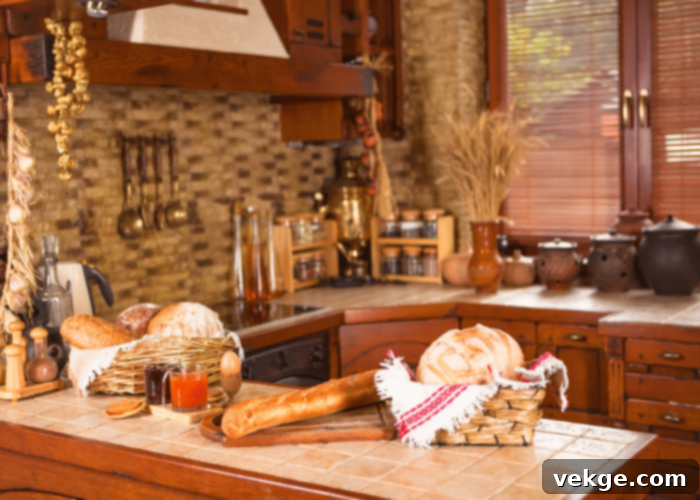
Traditional kitchen design is celebrated for its warm, inviting, and deeply hospitable atmosphere. This style frequently draws inspiration from historical periods, showcasing intricate detailing, luxurious materials, and a profound sense of handcrafted quality. Key features commonly found in traditional kitchens include:
- **Elaborate Cabinetry:** Look for cabinetry adorned with raised panel doors, elegant recessed panels (such as the enduring Shaker style), and charming glass-front doors designed to display treasured dishware. Wood species like oak, cherry, maple, and walnut are frequently used, often featuring rich, visible grain and warm, inviting finishes.
- **Rich Wood Finishes:** Stains, glazes, and often hand-distressed finishes are common, serving to enhance the natural beauty of the wood and add a layer of historical depth to the space.
- **Exquisite Craftsmanship:** Decorative elements are a hallmark of traditional design, including intricately carved corbels, sophisticated crown molding, gracefully turned legs on kitchen islands, and fluted columns, all adding architectural interest and a touch of grandeur.
- **Classic Color Schemes:** The palette typically encompasses warm, earthy tones such as creamy whites, antique off-whites, deep forest greens, rich blues, and various shades of brown, creating an inherently cozy and welcoming ambiance.
- **Ornate Hardware:** Cabinet pulls and knobs are often designed with intricate patterns, featuring antique finishes like oil-rubbed bronze, polished brass, or brushed pewter, meticulously chosen to complement the kitchen’s overall decorative style.
- **Warm and Layered Lighting:** Classic chandeliers, elegant wall sconces, and pendant lights with a more traditional aesthetic contribute to a soft, ambient glow, enhancing the kitchen’s welcoming feel.
This design philosophy cultivates a strong sense of comfort, familiarity, and nostalgia, making the kitchen feel like a well-established, cherished, and integral part of the home’s heritage.
Modern Kitchen Design: The Embodiment of Sleek Functionality
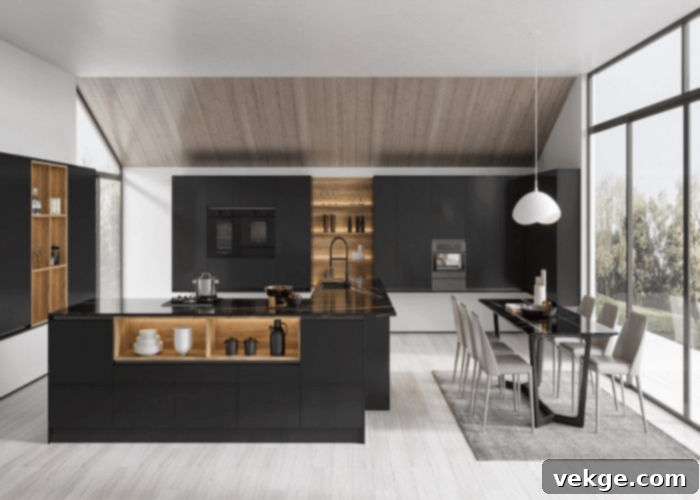
Standing in striking contrast, modern kitchen design champions a philosophy centered on streamlining, functional minimalism, and uncompromised utility. It emphasizes clean lines, expansive open spaces, and an uncluttered aesthetic, with a primary focus on efficiency and seamless technological integration. Defining characteristics frequently found in modern kitchens include:
- **Minimalist Cabinetry:** Flat-panel (slab) doors are a dominant feature, often designed without handles or with very discreet, integrated hardware to create utterly seamless surfaces. Finishes often include high-gloss lacquers, matte laminates, or subtly textured painted wood.
- **Neutral Color Schemes:** A foundational palette of crisp whites, cool grays, deep blacks, and natural earth tones is typical, sometimes accented with deliberate, bold splashes of color to create visual impact.
- **Smooth, Uninterrupted Surfaces:** Countertops and backsplashes frequently feature large, continuous expanses of materials like polished quartz, smooth concrete, or sleek stainless steel, accentuating a sense of cleanliness and effortlessness.
- **Industrial and Natural Materials:** Materials such as stainless steel, glass, unadorned stone, concrete, and minimalist wood are widely utilized, prized for their inherent beauty, durability, and functional properties.
- **Clean Lines and Geometric Precision:** The design deliberately eschews elaborate ornamentation, instead favoring strong horizontal and vertical lines to foster a sense of order, precision, and modern sophistication.
- **Integrated Appliances:** Appliances are often discreetly built directly into the cabinetry, contributing to the seamless, uninterrupted visual flow and maximizing spatial efficiency.
- **Sleek and Functional Lighting:** Recessed lighting, track lighting systems, and minimalist pendant lights with clean, geometric forms are favored to provide focused illumination without introducing visual clutter.
This design ethos conveys a profound sense of refined sophistication, exceptional efficiency, and a distinctly contemporary aesthetic, making it perfectly suited for the demands and aspirations of modern living.
Bringing Tradition and Modernity Together: A Guide to Harmonious Blending
The true artistry of a successful traditional modern kitchen lies in discovering a delicate equilibrium, where neither design style dominates the other, but instead, each element thoughtfully enhances and elevates its counterpart. Here’s how you can artfully fuse these two compelling aesthetics to create a kitchen that is both a retreat and a showpiece:
1. Cultivate a Harmonious Colour Scheme
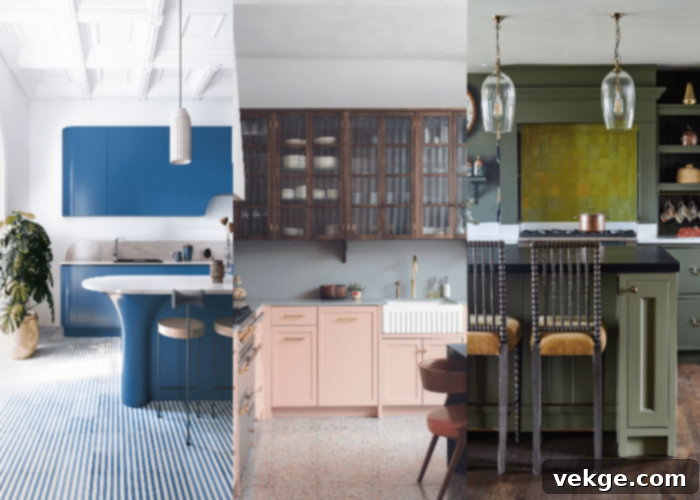
Initiate your design journey by selecting a color scheme that gracefully bridges the divide between classic and contemporary elements. A foundation of crisp whites, understated grays, and comforting creams provides an impeccable modern backdrop, offering a sense of openness and light. Into this sophisticated canvas, you can strategically introduce calculated splashes of color directly inspired by traditional hues. Envision a deep navy for a kitchen island, an earthy sage green for lower cabinets, or a rich burgundy as an accent wall. This can also manifest through smaller details like vibrant small appliances, a patterned backsplash crafted from ornamental tiles featuring subtle, traditional motifs, or even colorful textiles. The overarching objective is to establish a fluid visual dialogue where modern neutrals are warmed and imbued with character by traditional color accents, ensuring the space feels simultaneously fresh, inviting, and deeply personal.
2. Cabinetry with a Contemporary Twist and Classic Charm
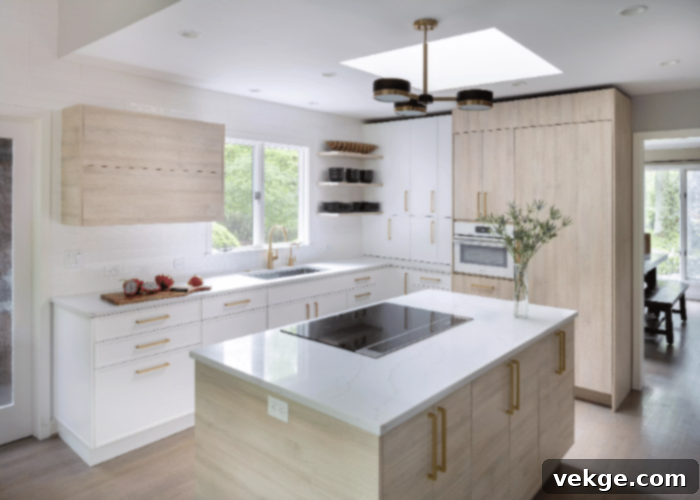
Cabinetry presents one of the most impactful opportunities to blend styles seamlessly. Rather than committing to strictly traditional or purely modern designs, embrace a thoughtful hybrid approach. Select cabinets that feature straightforward, clean lines—such as a classic Shaker style or even sleek flat-panel doors—but then subtly enhance them with traditional characteristics. This could involve incorporating raised panel doors on select upper cabinets, integrating decorative crown molding at the ceiling line, or utilizing glass-front doors to tastefully display a curated collection of ceramics. Conversely, a more traditional cabinet style, like a beaded inset door, can be given a modern update with minimalist hardware in finishes like brushed nickel or matte black. Experiment with combining materials, such as warm natural wood cabinetry paired with contemporary glass inserts or metallic accents, to achieve the perfect equilibrium between timeless coziness and modern sleekness. For inspiration, explore a diverse range of classic cabinet designs that possess the versatility to be subtly modernized.
3. Timeless Flooring for a Grounded Aesthetic
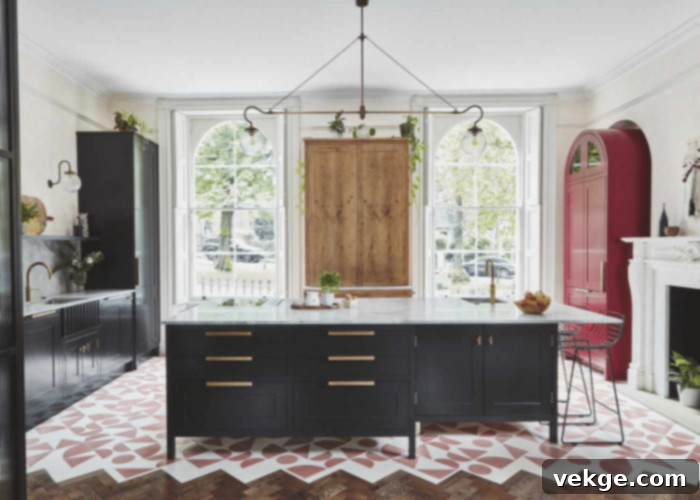
The flooring serves as the foundational layer for your kitchen’s entire aesthetic, and selecting a timeless material can effortlessly bridge traditional and modern elements. Opt for durable and aesthetically pleasing flooring materials such as natural stone (like travertine or slate), classic wide-plank hardwood, or large-format porcelain tiles that expertly mimic natural textures. Hardwood floors, for example, offer inherent warmth, rich character, and a traditional feel that beautifully complements sleek, minimalist modern cabinetry. Similarly, natural stone floors provide a sense of enduring elegance and sophisticated texture. If you wish to inject a touch more character, consider patterned tiles that subtly incorporate traditional motifs or geometric designs, rendered in a contemporary color palette. These versatile materials are adaptable enough to harmonize with both the rustic charm of traditional features and the refined sleekness of modern design components, grounding your space with an appeal that withstands the passage of time.
4. Contrasts in Countertops: Merging Textures and Tones
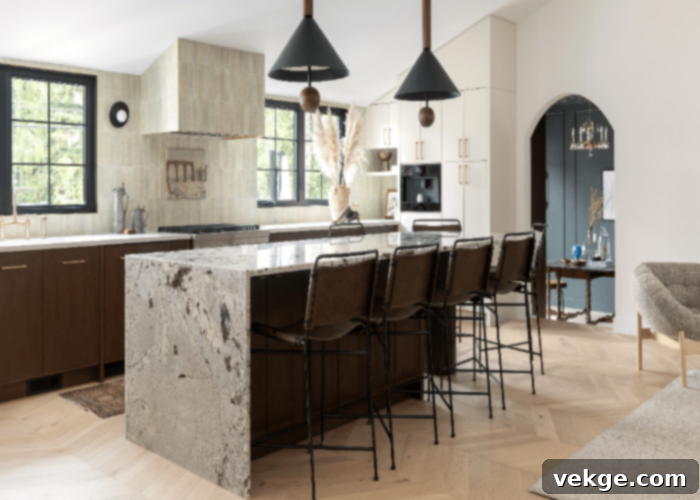
Countertops present another excellent opportunity to introduce captivating contrasting textures and colors, thereby creating profound visual interest and depth within your kitchen. Consider pairing a luxurious, highly polished marble or granite countertop—with its inherent sense of heritage, intricate veining, and undeniable elegance—with sleek, decidedly modern elements such as stainless steel appliances, a minimalist glass backsplash, or ultra-modern faucets. The organic patterns of natural stone offer a beautiful, soft contrast to the clean lines and reflective surfaces of contemporary fixtures. Alternatively, you could introduce a warm, inviting butcher-block island top to provide traditional warmth, surrounded by perimeter countertops crafted from a solid, contemporary quartz. The dynamic interplay between these diverse materials—a smooth, cool surface against a warm, textured one—expertly crafts a sophisticated and visually engaging hybrid look. Pay careful attention to edge profiles; a classic ogee or bullnose edge can soften the crisp sharpness of modern cabinets, while a simple, sleek waterfall edge can instantly modernize a more traditional base unit.
5. The Pivotal Importance of Layered Lighting
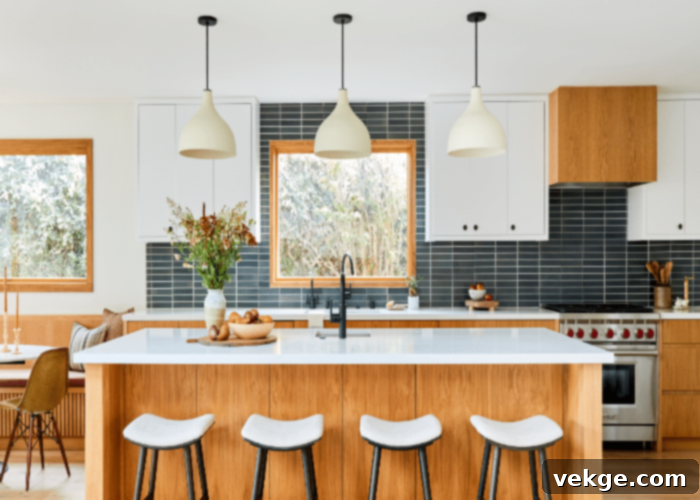
Lighting is far more than mere illumination; it is a critical design element that masterfully sets the mood, defines distinct zones, and artfully highlights architectural features. In a traditional modern kitchen, the strategic layering of various types of lighting can create captivating focal points and foster a truly harmonious ambiance. Combine the timeless elegance of vintage-inspired chandeliers or decorative pendant lights with the understated functionality of sleek, contemporary recessed lighting or discreet under-cabinet LED strips. For instance, a grand classic wrought-iron chandelier suspended above a modern dining area, or a pair of ornate brass pendants gracefully illuminating a minimalist island, can forge an intriguing visual dialogue. To maintain a cohesive atmosphere, ensure that the light temperatures (the warmth or coolness of the light) are consistent throughout or thoughtfully blended to achieve specific effects. This dynamic combination of opulent, decorative lighting fixtures and streamlined, functional illumination provides both compelling visual intrigue and practical versatility, rendering your kitchen adaptable for any occasion, from quiet mornings to lively gatherings.
6. Introduce Bold Statement Pieces
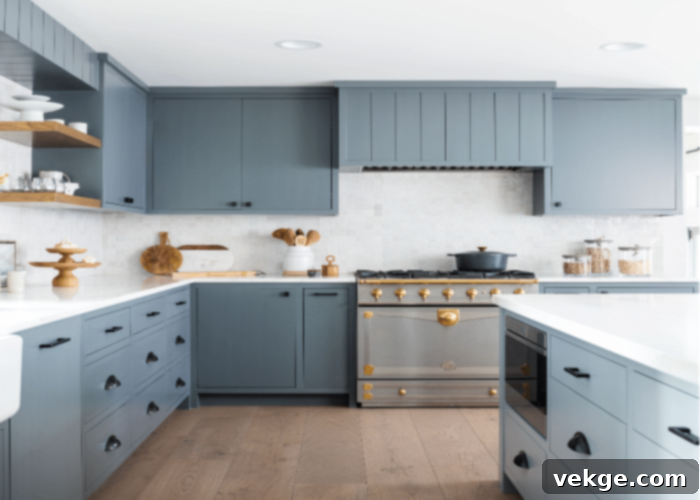
A thoughtfully selected statement piece can serve as the ultimate anchor for your traditional modern kitchen, seamlessly embodying and celebrating both aesthetics. Consider a kitchen island that perfectly exemplifies this sophisticated fusion: perhaps a traditionally styled base featuring intricate carvings, elegant paneled sides, or decorative corbels, expertly topped with a contemporary, thick slab countertop crafted from quartz or concrete. Another compelling idea is to install a vintage-style, ornate range hood over a sleek, modern induction cooktop, or to pair a classic, deep farmhouse sink with ultra-modern, industrial-style faucets. This central, bold element will naturally command attention, acting as the room’s undeniable focal point and a powerful testament to your ability to combine traditional and modern kitchen design with remarkable agility and grace. Ensure the piece is proportionate to the overall space and enhances the kitchen’s flow, rather than overpowering it, to achieve perfect harmony.
7. Curated Displays on Open Shelves
Open shelving provides an unparalleled platform for showcasing your uniquely curated style, allowing you to elegantly display a thoughtful blend of both contemporary and classic artifacts. Instead of relying solely on closed upper cabinets, integrate strategically placed open shelves. On these shelves, artfully arrange a variety of sleek, minimalist contemporary dishes, modern cookbooks, and refined ceramics alongside cherished antique or historic cookware, precious family heirlooms, or vintage decorative objects. The compelling juxtaposition of a modern, geometric vase next to a rustic, handcrafted bowl, or a stack of bright white plates beside a timeworn copper pot, instantly creates dynamic visual interest and tells a rich narrative. This type of display not only injects character and a personalized touch into your kitchen but also expertly demonstrates how two distinct design philosophies can coexist beautifully, fostering a layered and lived-in atmosphere that feels both authentic and stylish.
8. Thoughtful Details and Accent Elements
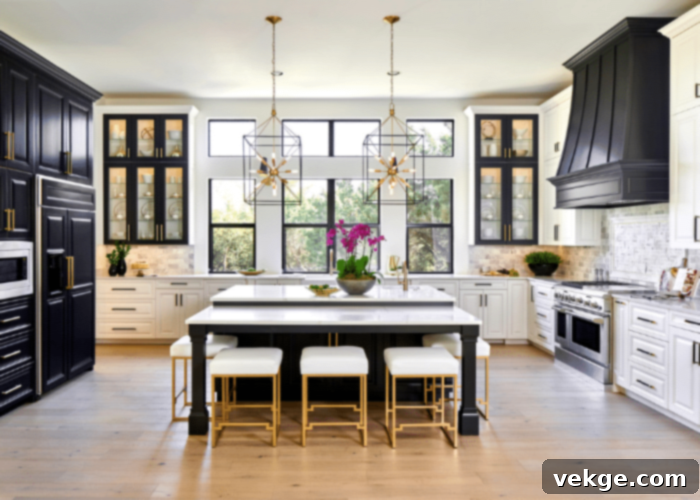
Often, it is the small, meticulously chosen details that exert the most profound influence on a kitchen’s overall aesthetic and its ability to blend styles. These accent elements are your opportunity to finely tune the balance between traditional and modern. Consider adding traditional finishing touches to predominantly contemporary surfaces, such as installing a decorative backsplash with subtly patterned ceramic tiles, incorporating intricate molding around windows or doorways, or introducing carved wooden accents on a sleek island panel. Conversely, boldly infuse modern design components into more historically inspired settings, like selecting minimalist, high-arc pull-down faucets in a polished chrome or matte black finish for a classic farmhouse sink, or updating traditional cabinetry with sleek, brushed stainless steel hardware. Even seemingly minor elements like cabinet pulls, drawer handles, and lighting switch plates can significantly contribute to this delicate balance, ensuring that every corner of your kitchen thoughtfully reflects your hybrid design vision.
9. The Richness of Textures and Fabrics
Experimenting with a diverse array of textures and materials is an exceptionally effective method to introduce warmth, profound depth, and inviting comfort into your hybrid kitchen. Soften the potentially stark or clinical edges of a modern space with inviting fabrics and natural textures. Imagine plush, upholstered bar stools providing a tactile contrast to a sleek, hard island surface, or elegant window treatments crafted from linen or cotton showcasing a subtle, traditional pattern. A richly textured area rug can define a seating or dining area, adding an immediate layer of comfort, color, and visual interest. Incorporate natural wood elements, exposed brick walls, or raw stone accents to bring in an organic, rustic, and traditional feel, which contrasts beautifully with polished modern surfaces like glass, high-gloss cabinetry, or stainless steel. To create a strong sense of integration, consider utilizing fabrics with classic or ancient designs, but rendered in contemporary color palettes. This tactile and visual interplay not only adds complexity and beauty but also makes the kitchen feel more layered, welcoming, and deeply personal.
10. Infuse Personal Touches and Authenticity
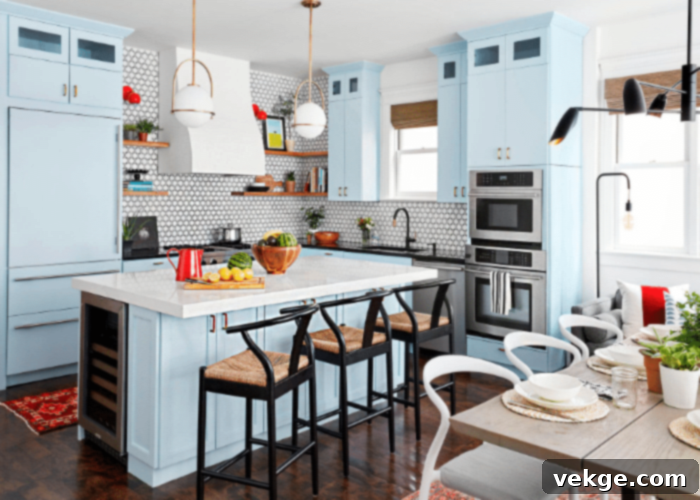
Ultimately, a truly exceptional and beloved kitchen is one that authentically reflects your unique personality, lifestyle, and individual story. Integrate meaningful personal touches that celebrate your life, cultural heritage, and cherished memories. Display beloved family recipes in sleek, modern frames on an open shelf, or proudly showcase sentimental items like antique pottery, inherited serving ware, or unique travel souvenirs that bridge cultural and temporal divides. A curated collection of vintage art prints set against a minimalist white wall, or a vibrant indoor plant adding life and organic form to a sleek, modern countertop, can all contribute to this authentic and heartfelt blend. By thoughtfully incorporating objects that hold profound meaning to you, you infuse the space with an irreplaceable character and warmth. This personal touch is the final, essential ingredient, lending authenticity and a compelling narrative to your traditional modern kitchen design, ensuring it’s not merely a beautifully designed room, but a true reflection of you and your cherished home.
Conclusion: Crafting Your Enduring Kitchen Legacy
The ambitious endeavor of combining traditional and modern kitchen design is far more than simply merging two distinct aesthetic styles; it’s about forging a dynamic, highly functional, and enduring space that profoundly celebrates the very best attributes of both worlds. It represents an unparalleled opportunity to create a kitchen that offers the timeless comfort, rich detailing, and inviting warmth of classic aesthetics, while simultaneously embracing the clean lines, cutting-edge efficiency, and forward-thinking functionality inherent in contemporary design. By making deliberate, thoughtful, and informed choices about your materials, color palettes, finishes, and specific design components, you can craft a kitchen that not only exudes stunning visual appeal but also functions flawlessly and gracefully withstands the test of time, effortlessly resisting the ebb and flow of fleeting trends.
Mastering the intricate skill of blending diverse design styles empowers you to design a kitchen that is not merely practical and visually captivating, but also a profound and authentic representation of your individual preferences, unique personality, and contemporary way of life. This hybrid approach offers unparalleled versatility and adaptability, allowing your kitchen to evolve seamlessly with your changing needs while consistently retaining its core charm and distinctive character. So, embrace this imaginative design adventure with unwavering confidence and boundless creativity. Observe with delight as your kitchen undergoes a remarkable transformation, becoming an alluring fusion of rich heritage and innovative design—a truly unique, cherished, and inspiring space for countless years to come.
